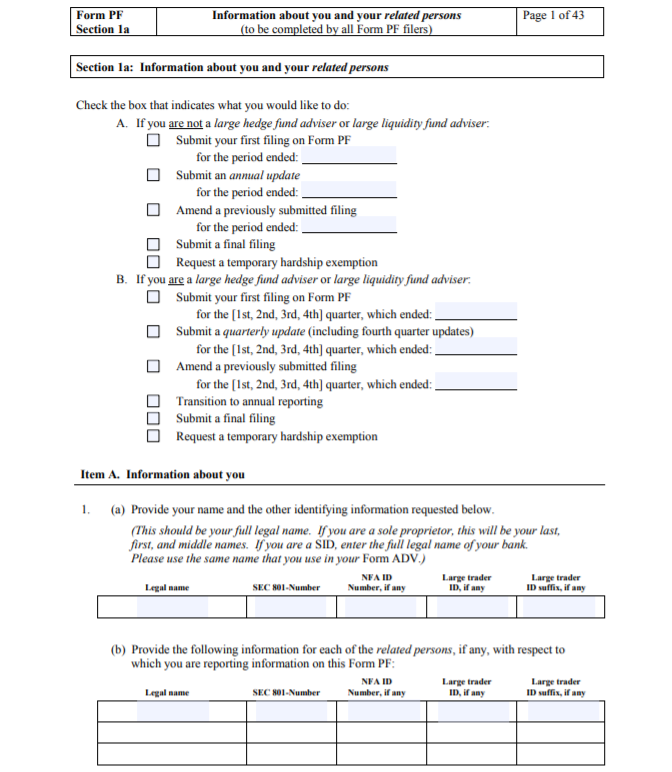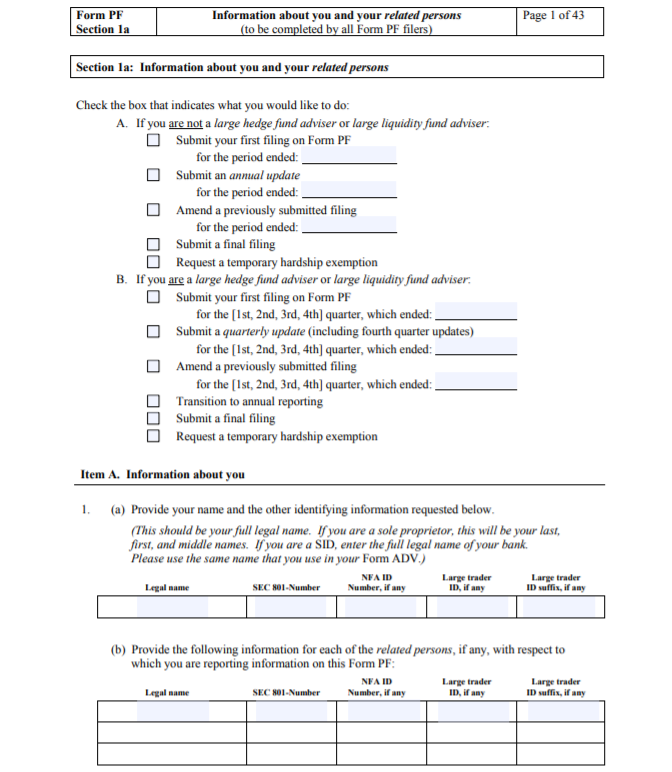This blog post was updated on January 5th, 2022 to reflect current regulatory guidance and the latest data for registered investment adviser “RIA” firms managing private funds.
The primary regulatory filing requirement for a registered investment adviser (“RIA”) firm is the Form ADV. The Form ADV Part 1 and Part 2 are filed via the online Investment Adviser Registration Depository (“IARD”) system. However, some RIA firms that advise private funds may also be required to file a Form PF via the IARD system as well.
According to the latest publicly available data from the Securities and Exchange Commission (“SEC”) Analytics Office, as of Q3 2020, there are more than 3,200 private fund advisers advising roughly 35,000 private funds that currently file a Form PF.
In this article, we will discuss when an RIA firm managing a private fund may be required to submit a Form PF.
Which RIA firms need to file a Form PF?
According to the SEC’s Form PF general instructions, an RIA firm is required to compile and file a Form PF when all three of the following characteristics are met:
- The firm is registered or required to federally register with the SEC as investment adviser AND
- the firm manages one or more private funds AND
- the firm (and its related persons) collectively manage at least $150 million in private fund assets under management (“AUM”) as of the last day of the most recently completed fiscal year.
Related: Click here to access the most recent version of the Form PF from the SEC website
Private fund assets under management are defined by the SEC as “the portion of such adviser’s regulatory assets under management that are attributable to private funds it advises.” In other words, just because an RIA firm manages more than $150 million in regulatory assets under management does not mean it needs to file a Form PF. Rather, the firm must manage one or more private funds with at least $150 million directly attributable to those private funds.
A Few Examples:
Here are a few examples to further illustrate when a firm may or may not be required to file a Form PF:
- Scenario A
- An SEC-registered RIA firm with $550 million in regulatory AUM manages three hedge funds, which total $125 million in aggregate private fund AUM.
- No, this firm would generally not be required to file a Form PF since it manages less than $150 million in private fund AUM.
- An SEC-registered RIA firm with $550 million in regulatory AUM manages three hedge funds, which total $125 million in aggregate private fund AUM.
- Scenario B
- An SEC-registered RIA firm with $155 million in regulatory AUM exclusively manages a single private equity fund with $155 million in private fund AUM.
- Yes, this firm would generally be required to file a Form PF since it is SEC-registered and manages more than $150 million in private fund AUM.
- An SEC-registered RIA firm with $155 million in regulatory AUM exclusively manages a single private equity fund with $155 million in private fund AUM.
- Scenario C
- A state-registered RIA firm with $90 million in regulatory AUM exclusively manages a single hedge fund with $90 million in private fund AUM
- No, this firm would generally not be required to file a Form PF since it is state-registered and manages less than $150 million in private fund AUM.
- A state-registered RIA firm with $90 million in regulatory AUM exclusively manages a single hedge fund with $90 million in private fund AUM
Also, it’s important to note that a private fund is defined as:
Any issuer that would be an investment company as defined in section 3 of the Investment Company Act of 1940 but for section 3(c)(1) or 3(c)(7) of that Act. If any private fund has issued two or more series (or classes) of equity interests whose values are determined with respect to separate portfolios of securities and other assets, then each such series (or class) should be regarded as a separate private fund. This only applies with respect to series (or classes) that you manage as if they were separate funds and not a fund’s side pockets or similar arrangements.
Which sections does a private fund need to complete on the Form PF?

All Form PF filers, regardless of private fund AUM, must complete Section 1a and Section 1b. All private fund advisers required to file a Form PF that advise one or more hedge funds, regardless of total hedge fund AUM, are required to complete section 1c. Some larger private fund advisers may also be required to complete additional section(s) of the Form PF:
- “Large hedge fund advisers” designated as firms and related persons that collectively manage at least $1.5 billion in hedge fund AUM are required to complete Section 2.
- “Large liquidity fund advisers” designated as firms and related persons that collectively manage at least $1.0 billion in liquidity fund AUM are required to complete Section 3 for each liquidity fund.
- “Large private equity advisers” which are designated as firms and related persons that collectively manage at least $2.0 billion in private equity fund AUM are required to complete Section 4 for each private equity fund.
Where do I file the Form PF (and how much does it cost)?
All Form PF filings are submitted via the private fund reporting depository (“PFRD”) which is part of the IARD online filing system. The IARD system assesses a $150 fee on all Form PF filings.
Does a state-registered or exempt reporting adviser (“ERA”) need to file a Form PF?
Given the criteria above, SEC-registered RIA firms with less than $150 million in private fund AUM, exempt reporting advisers, and state-registered RIA firms are generally not required to file a Form PF. However, it’s important to note that those firms are still generally required to file a Form ADV, which will disclose general information about the private funds they manage.
Note:Click here to see our overview of ERA registration requirements
When must an RIA firm managing a private fund file a Form PF?
While large hedge fund advisers, large private equity advisers, and large liquidity fund advisers are required to submit quarterly Form PF filings, all other private fund advisers are generally required to file an annual Form PF update within 120 calendar days after the end of the fund’s fiscal year.
RIA firms filing a Form PF for the first time will disclose it is the firm’s initial Form PF filing. Going forward, the firm will then disclose that it is submitting a quarterly or annual update.
We strongly recommend that your firm’s Chief Compliance Officer further review the SEC’s Form PF general instructions and frequently asked questions to ensure all guidance is properly followed.
Did you know that our online compliance platform, MyRIACompliance, has a version custom-made for private fund advisers? It includes access to our proprietary Private Fund Platform, as well as an optional enhanced service package with one-on-one expert private fund compliance consultants to help answer questions, develop customized policies and procedures, and review marketing and regulatory filing documents.
Note: The information contained herein is an overview of certain private fund regulatory compliance considerations. It is not intended to be a comprehensive analysis or apply to any one private fund’s particular situation.
